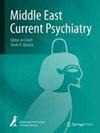与使用曲马多有关的大脑退行性变化:光学相干断层扫描研究
IF 1.6
Q3 PSYCHIATRY
引用次数: 0
摘要
曲马多(Tramadol)是一种合成阿片类药物,最初用作镇痛剂,近二十年来在中东地区作为一种成瘾药物被广泛滥用。与长期使用曲马多有关的脑部变化尚未得到充分研究。本研究旨在检测使用曲马多至少一年对大脑可能产生的影响。光学相干断层扫描(OCT)作为一种无创测量方法,可评估视网膜厚度的变化,而视网膜厚度的变化可反映大脑的退行性变化。研究人员将符合《精神疾病诊断与统计手册》第五版(DSM-5)标准的25名曲马多使用障碍患者与25名无药物使用障碍的匹配对照受试者进行了比较。两组患者均排除了可能影响 OCT 的其他精神和医疗状况。使用成瘾严重程度指数对患者进行评估,同时使用 OCT 对两组患者进行评估。与未服用曲马多的健康对照组相比,服用曲马多的患者大多数 OCT 参数的厚度较低。视网膜神经纤维层(RNFL)厚度与曲马多剂量、使用时间或首次使用年龄无关。左右眼的视网膜神经纤维层(RNFL)和神经节细胞复合体(GCC)厚度存在差异。长期服用曲马多会导致RNFL厚度下降,而RNFL可能是通过OCT等非侵入性技术检测退化的潜在标志和早期信号。本文章由计算机程序翻译,如有差异,请以英文原文为准。
Degenerative brain changes associated with tramadol use: an optical coherence tomography study
Tramadol—a synthetic opioid originally used as an analgesic—has been widely misused as an addictive drug in the middle east in the last twenty years. Brain changes associated with long-term tramadol use are understudied. This study aimed to detect the possible effects of tramadol use for at least one year on the brain. Optical coherence tomography (OCT) as a noninvasive measure can assess changes in retinal thickness which reflects degenerative changes in the brain. Twenty-five patients fulfilling the tramadol use disorder according to the Diagnostic and Statistical Manual of Mental Disorders, fifth edition (DSM-5) criteria were compared to 25 matched control subjects free of substance use disorders. Other psychiatric and medical conditions that may affect OCT were excluded from both groups. Patients were assessed using Addiction Severity Index; meanwhile, both groups were evaluated using OCT. Patients with tramadol use showed a lower thickness of most OCT parameters than healthy non-tramadol controls. The retinal nerve fiber layer (RNFL) thickness was not associated with tramadol dose, duration of use, or the age of first use. There were differences between the right and left eyes in RNFL and Ganglion cell complex (GCC) thickness. Long-term tramadol use is associated with decreased thickness of RNFL that can be a potential marker and an early sign for degeneration detected by noninvasive techniques like OCT.
求助全文
通过发布文献求助,成功后即可免费获取论文全文。
去求助
来源期刊

Middle East Current Psychiatry
Medicine-Psychiatry and Mental Health
CiteScore
3.00
自引率
0.00%
发文量
89
审稿时长
9 weeks
 求助内容:
求助内容: 应助结果提醒方式:
应助结果提醒方式:


